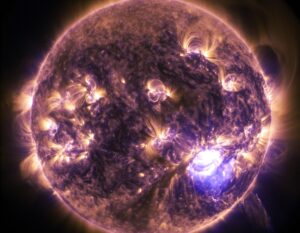The Beginning
A Journey from the Big Bang to First Atoms
In this section, we will learn how the universe began as a singularity, a point of infinite density and temperature and how as it expanded and cooled, subatomic particles such as protons and neutrons began to form. We will learn how these particles eventually came together to form the first atoms, primarily hydrogen and helium, through a process called nucleosynthesis.
Preview: 3D Model of Hydrogen and Helium atoms
Consider something unbelievably tiny, unbelievably dense, and incredibly hot. Then, suddenly, space, time, and all molecular matter burst in ways that no words can express. What is known is that the Universe expanded at an unfathomable rate in a fraction of a second. Some recognised subatomic particles and fundamental forces emerged as a result of this expansion. The Universe then began to cool drastically, to around 1 billion degrees Celsius, allowing energy and, ultimately matter to emerge.
The expansion of the universe is still ongoing, and the universe is still cooling.
It is important to note that the Big Bang theory is not a description of an explosion in the traditional sense, but rather the expansion of space-time itself. The matter and energy in the universe did not explode out from a central point, but rather, space-time began to expand and "carry" the matter and energy along with it.
It's also important to note that the Big Bang theory does not address the question of what caused the singularity to begin expanding, or what existed before the singularity.
The shortest period of time with any physical meaning. It is the smallest time interval that can be measured. The Planck time denotes the scale beyond which present physics theories fail.
In other words, Planck time is thought to be the smallest unit of time that could ever be physically meaningful, as any smaller units would be subject to the uncertainty principle of quantum mechanics.
Planck time has implications in the early universe, specifically in the understanding of the first moments after the Big Bang. It represents the earliest possible time that can be meaningfully described in our current understanding of physics, and it is thought to be the time scale at which quantum gravity, the theory that unifies quantum mechanics and general relativity, would have become important. But, Planck time is a theoretical concept, and the real physics of the early universe is still not well understood.
Around this time, the universe expanded at an inconceivable speed, from far less than an atom to enormous size.
The fundamental forces: Gravity (the force that pulls everything together), Electromagnetism, weak, and strong interaction (the force that holds nuclei together) emerged.
Quantum fluctuations are small, temporary changes in the amount of energy present in a point in space. Quantum fluctuations produce the microscopic 'wrinkles' in density that keep the universe from becoming completely uniform and homogeneous. They can lead to the creation of virtual particles, such as particle-antiparticle pairs. This paved the path for subatomic particles like quarks to be formed.
The expansion had relatively slowed down. Due to quantum fluctuations subatomic particle like quarks were formed which were the building blocks of protons and neutrons. Quarks and antiquarks formed and annihilated each other. The remaining quarks accounted for one billionth of the prior mass of quarks and antiquarks.
Electron-positron pairs were created and annihilated, leaving 1/billionth the amount of electrons and positrons behind.
Quarks combined to generate protons and neutrons. Two up quarks and one down quark make up a proton, while one up quark and two down quarks make up a neutron.
As the universe cooled, these neutrons and protons combined further to form hydrogen and helium nuclei. The hydrogen nuclei contained only a single proton while helium nuclei was made up of two protons and two neutrons. Deuterium, Helium-3, and lithium-7 were also formed in trace amounts.
The universe consisted of plasma (superheated state of ordinary matter) of nuclei, electrons, and photons; temperatures were too high for electrons to attach to the nuclei. Because photons of light were tangled up in these charged particles, they couldn't flow freely through the universe. Hence, the universe was utterly Dark.
As the universe expanded, plasma grew cooler and cooler. The universe cooled down further to 3000 K, making it possible for the nuclei in the plasma to gain electrons and become full-fledged neutral Hydrogen and Helium atoms.

Photons of light tangled in the plasma could now move freely and were released. The universe became transparent for the first time. This is known as cosmic microwave background that we can see even today.

Time is Up!

Time’s up

